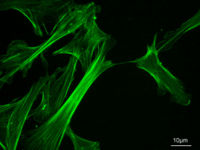Cytoskeleton: Difference between revisions
imported>Gareth Leng No edit summary |
imported>Gareth Leng |
||
| Line 8: | Line 8: | ||
===Actin filaments=== | ===Actin filaments=== | ||
About 7 nm in diameter, [[actin]] filaments are composed of two actin chains oriented in an helicoidal shape. They are mostly concentrated just beneath the plasma membrane, as they keep cellular shape, form cytoplasmatic protuberances (like [[pseudopod|pseudopodia]] and [[microvillus| | |||
microvilli]]), and participate in some cell-to-cell or cell-to-matrix junctions and in the [[transduction]] of signals. They are also important for [[cytokinesis]] and, along with [[myosin]], [[Skeletal muscle|muscular contraction]]. | microvilli]]), and participate in some cell-to-cell or cell-to-matrix junctions and in the [[transduction]] of signals. They are also important for [[cytokinesis]] and, along with [[myosin]], [[Skeletal muscle|muscular contraction]]. | ||
===Intermediate filaments=== | ===Intermediate filaments=== | ||
[[Intermediate filament]]s, 8-11 nanometers in diameter, are the more stable (strongly bound) and heterogeneous constituents of the cytoskeleton. | |||
They organize the internal tridimensional structure of the cell (they are structural components of the [[nuclear envelope]] or the [[sarcomere]]s for example). They also participate in some cell-cell and cell-matrix junctions. | They organize the internal tridimensional structure of the cell (they are structural components of the [[nuclear envelope]] or the [[sarcomere]]s for example). They also participate in some cell-cell and cell-matrix junctions. | ||
| Line 27: | Line 22: | ||
===Microtubules=== | ===Microtubules=== | ||
[[Microtubule]]s are hollow cylinders of about 25 nm in diameter, formed by 13 protofilaments which are polymers of alpha and beta [[tubulin]]. They have a very dynamic behaviour, binding [[Guanosine triphosphate|GTP]] for polymerization. They are organized by the [[centrosome]]. | |||
[[ | |||
They play key roles in: | They play key roles in: | ||
| Line 38: | Line 29: | ||
*the [[mitotic spindle]]. | *the [[mitotic spindle]]. | ||
*synthesis of the cell wall in plants. | *synthesis of the cell wall in plants. | ||
==The cytoskeleton in prokaryote cells== | ==The cytoskeleton in prokaryote cells== | ||
Revision as of 13:07, 23 January 2011
The cytoskeleton is a cellular "scaffolding" or "skeleton" contained, as all other organelles, within the cytoplasm of all eukaryotic cells. It is a dynamic structure that maintains cell shape, enables some cell motion (using structures such as flagella and cilia), and has important roles in both intra-cellular transport (the movement of vesicles and organelles, for example) and cell division.
The cytoskeleton in eukaryotic cells
Eukaryotic cells contain three kinds of cytoskeletal filaments.
Actin filaments
About 7 nm in diameter, actin filaments are composed of two actin chains oriented in an helicoidal shape. They are mostly concentrated just beneath the plasma membrane, as they keep cellular shape, form cytoplasmatic protuberances (like pseudopodia and microvilli), and participate in some cell-to-cell or cell-to-matrix junctions and in the transduction of signals. They are also important for cytokinesis and, along with myosin, muscular contraction.
Intermediate filaments
Intermediate filaments, 8-11 nanometers in diameter, are the more stable (strongly bound) and heterogeneous constituents of the cytoskeleton. They organize the internal tridimensional structure of the cell (they are structural components of the nuclear envelope or the sarcomeres for example). They also participate in some cell-cell and cell-matrix junctions.
Different intermediate filaments are:
- made of vimentins, being the common structural support of many cells.
- made of keratin, found in skin cells, hair and nails.
- neurofilaments of neural cells.
- made of lamin, giving structural support to the nuclear envelope.
Microtubules
Microtubules are hollow cylinders of about 25 nm in diameter, formed by 13 protofilaments which are polymers of alpha and beta tubulin. They have a very dynamic behaviour, binding GTP for polymerization. They are organized by the centrosome.
They play key roles in:
- intracellular transport (associated with dyneins and kinesins they transport organelles like mitochondria or vesicles).
- the axoneme of cilia and flagella.
- the mitotic spindle.
- synthesis of the cell wall in plants.
The cytoskeleton in prokaryote cells
The cytoskeleton was previously thought to be a feature only of eukaryotic cells, but homologues to the major proteins of the eukaryotic cytoskeleton have recently been found in prokaryotes. Although the evolutionary relationships are so distant that they are not obvious from protein sequence comparisons alone, the similarity of their three-dimensional structures provides strong evidence that the eukaryotic and prokaryotic cytoskeletons contain are homologous components.
FtsZ
FtsZ, a was the first protein of the prokaryotic cytoskeleton to be identified. Like tubulin, FtsZ forms filaments in the presence of GTP, but these filaments do not group into tubules. During cell division, FtsZ is the first protein to move to the division site, and is essential for recruiting other proteins that produce a new cell wall between the dividing cells.
MreB and ParM
Prokaryotic actin-like proteins, such as MreB, are involved in the maintenance of cell shape. All non-spherical bacteria have genes encoding actin-like proteins, and these proteins form a helical network beneath the cell membrane that guides the proteins involved in cell wall biosynthesis.
Some plasmids encode a partitioning system that involves an actin-like protein ParM. Filaments of ParM exhibit dynamic instability, and may partition plasmid DNA into the dividing daughter cells by a mechanism analogous to that used by microtubules during eukaryotic mitosis.
Crescentin
The bacterium Caulobacter crescentus contains a third protein, crescentin, that is related to the intermediate filaments of eukaryotic cells. Crescentin is also involved in maintaining cell shape, but the mechanism by which it does this is currently unclear.
